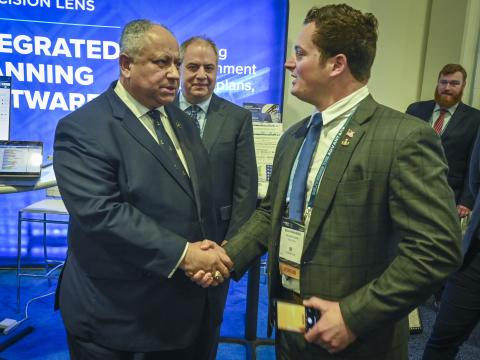Chief Information Warriors Describe Imminent Changes
The stars were out this morning as Lt. Gen. Dennis Via, USA, director, C4 systems, J-6, the Joint Staff, kicked off today's MILCOM 2009 activities.
The stars were out this morning as Lt. Gen. Dennis Via, USA, director, C4 systems, J-6, the Joint Staff, kicked off today's MILCOM activities. In addition to Gen. Via, a panel of four high-ranking military officials responsible for solving some of the most difficult problems the U.S. faces today explained what their organizations are doing to address the concerns surrounding the theme of the event "The Challenge of Convergence." Panel members agreed that these challenges are going to change drastically as the U.S. military draws down the number of its troops in Iraq while ramping up the troop count in Afghanistan. Gen. Via opened the session with insights he gained from his chats with the chairman and vice chairman of the Joint Chiefs of Staff (JCS). Both Adm. Mike Mullen, USN, and Gen. James E. Cartwright, USMC, understand the value of communications and the power of the network. As evidence of this understanding, Gen. Via quoted the vice chairman as saying, "I don't want the chain of command to inhibit the chain of information." This quote struck a chord with the other panelists. Brig. Gen. (P) Mark S. Bowman, USA, director of architecture, operations, networks and space, office of the chief information officer/G-6, U.S. Army, stated that the military must now perform a balancing act. Until this past year, 80 percent of the resources-people, equipment, money-went to Iraq, leaving less than 20 percent for Afghanistan. Some success has been achieved in Iraq, but it is a "fragile peace," and to sustain peace in the country, the U.S. must build strategic over-watch bases that must be smaller because the Pentagon's appetite to spend more money on activity in Iraq is low, but the needs are still there, he stated. These bases will continue to require communication systems, and while new systems can be risky, they are absolutely worth the risks, Gen. Bowman added. Rear Adm. Diane E.H. Webber, USN, director, command control systems, J-6, NORAD/NORTHCOM, says her organization is looking for applications that help the staff share information. There are some persistent themes in the shortfalls in the commands' ability to provide the JCS with the information it needs, the admiral noted. These include the lack of a common operational picture, the inability to share information, the multiple levels of security information issues, and command and control technology that is not interoperable with other technology sets, Adm. Webber stated. The unique mission sets of NORAD/NORTHCOM forces her to look for creative solutions to problems, she admitted, including turning to commercial products directly from retail outlets to grab and share information from different places. Brig. Gen. LaWarren V. Patterson, USA, deputy commander, U.S. Army Network Enterprise Technology Command/9th Signal Command, says that the Army is currently reviewing and overhauling its doctrine on how it buys IT across warfighting. During this review, the service is facing the same challenges as the rest of DOD: the immediate requirements from Iraq and Afghanistan; the threats in cyberspace; fragmented networks; and increasing constrained resources. The primary tool the service is using to meet these challenges is the Global Network Enterprise Construct to operationalize the LandWarNet. Brig. Gen. David B. Warner, USAF, director, communications and information, and CIO of Headquarters, Air Force Space Command (AFSC), related that a year ago, Air Force leaders met and made several monumental decisions. One was to stand up a command to focus on the nuclear mission; in August 2009, the Global Strike Command was stood up. The service also has been working for some time to stand up a cyber command. At the same October 2008 meeting, leaders decided to assign that mission to AFSC, and the Air Force has been designated as the lead major command "for all things cyber," Gen. Warner stated. To support this mission, the Air Force stood up a combatant numbered Air Force for cyber, which has three wings: the Net Warfare Wing, which focuses on the network today; the Combat Communications Wing, which the general called the "tomorrow force;" and the Information Operations Wing, which focuses on what's next in as little as a couple of hours or a couple of minutes as the military is fighting, the general explained.



